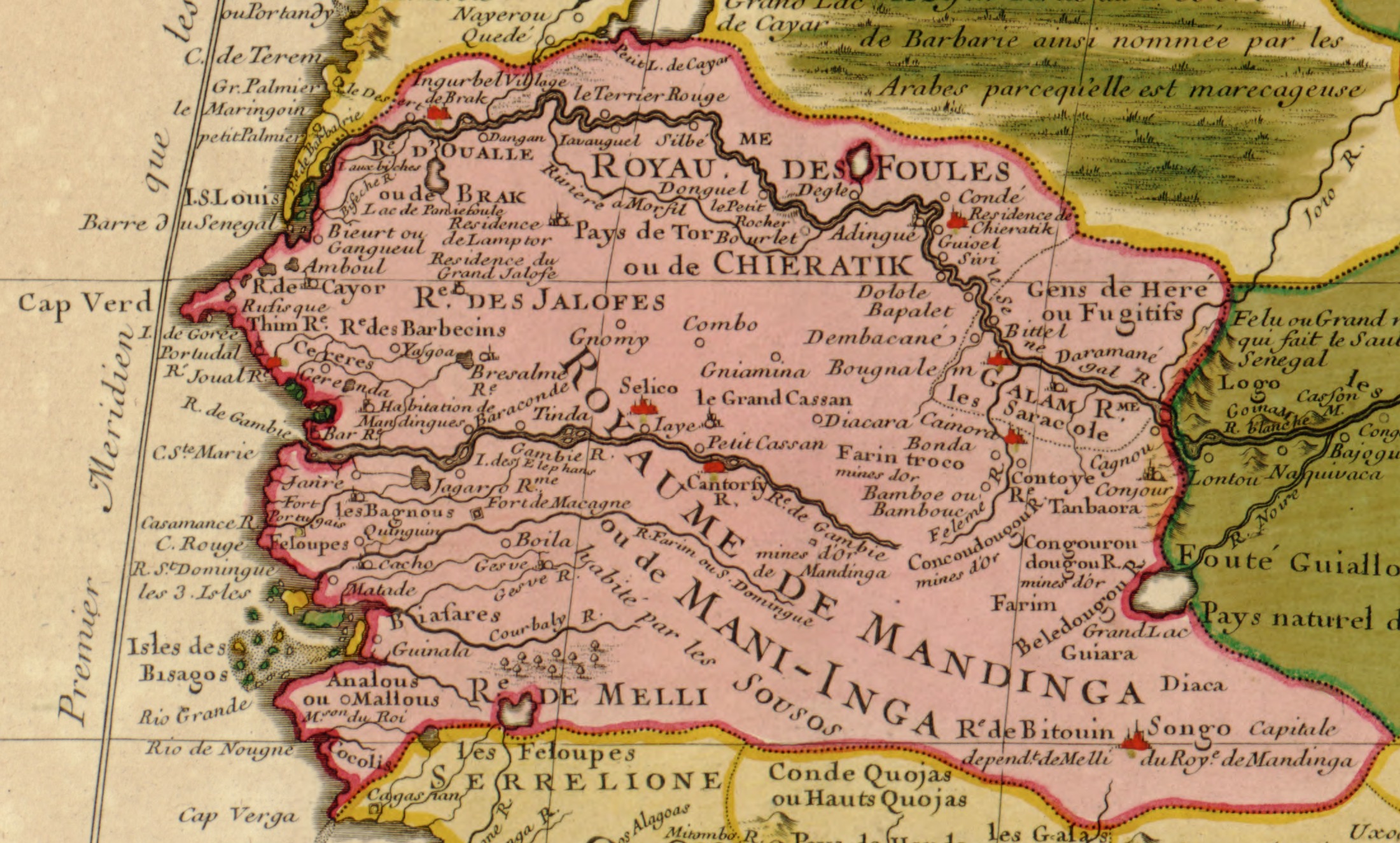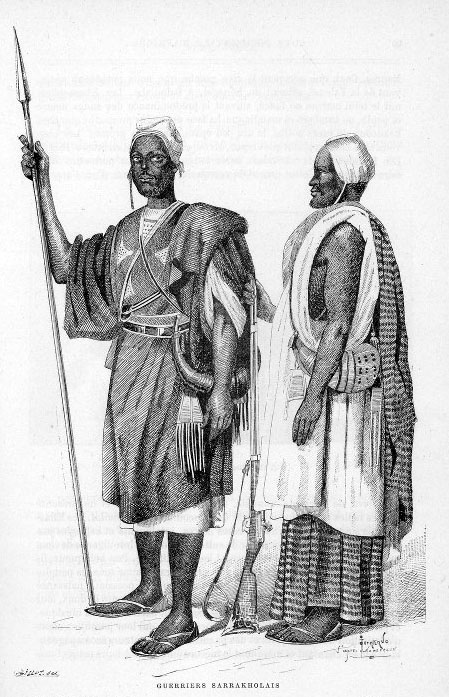|
Sénégal
Senegal,; Wolof: ''Senegaal''; Pulaar: 𞤅𞤫𞤲𞤫𞤺𞤢𞥄𞤤𞤭 (Senegaali); Arabic: السنغال ''As-Sinighal'') officially the Republic of Senegal,; Wolof: ''Réewum Senegaal''; Pulaar : 𞤈𞤫𞤲𞤣𞤢𞥄𞤲𞤣𞤭 𞤅𞤫𞤲𞤫𞤺𞤢𞥄𞤤𞤭 (Renndaandi Senegaali); Arabic: جمهورية السنغال ''Jumhuriat As-Sinighal'') is a country in West Africa, on the Atlantic Ocean coastline. Senegal is bordered by Mauritania to the north, Mali to the east, Guinea to the southeast and Guinea-Bissau to the southwest. Senegal nearly surrounds the Gambia, a country occupying a narrow sliver of land along the banks of the Gambia River, which separates Senegal's southern region of Casamance from the rest of the country. Senegal also shares a maritime border with Cape Verde. Senegal's economic and political capital is Dakar. Senegal is notably the westernmost country in the mainland of the Old World, or Afro-Eurasia. It owes its name to the ... [...More Info...] [...Related Items...] OR: [Wikipedia] [Google] [Baidu] |
History Of Senegal
The history of Senegal is commonly divided into a number of periods, encompassing the prehistoric era, the precolonial period, colonialism, and the contemporary era. Paleolithic The earliest evidence of human life is found in the valley of the Falémé in the south-east. The presence of man in the Lower Paleolithic is attested by the discovery of stone tools characteristic of Acheulean such as hand axes reported by Théodore Monod at the tip of Fann in the peninsula of Cap-Vert in 1938, or cleavers found in the south-east. There were also found stones shaped by the Levallois technique, characteristic of the Middle Paleolithic. Mousterian Industry is represented mainly by scrapers found in the peninsula of Cap-Vert, as well in the low and middle valleys of the Senegal and the Falémé. Some pieces are explicitly linked to hunting, like those found in Tiémassass, near M'Bour, a controversial site that some claim belongs to the Upper Paleolithic, while other argue i ... [...More Info...] [...Related Items...] OR: [Wikipedia] [Google] [Baidu] |
Macky Sall
Macky Sall (, wo, Maki Sàll, fuc, 𞤃𞤢𞤳𞤭 𞤅𞤢𞤤, italic=no, Maki Sal; born 11 December 1961) is a Senegalese politician who has been President of Senegal since April 2012. He was re-elected President in the first round voting in February 2019. Under President Abdoulaye Wade, Sall was Prime Minister of Senegal from July 2004 to June 2007 and President of the National Assembly from June 2007 to November 2008. He was the Mayor of Fatick from 2002 to 2008 and held that post again from 2009 to 2012. Sall was a long-time member of the Senegalese Democratic Party (PDS). After coming into conflict with Wade, he was removed from his post as President of the National Assembly in November 2008; he consequently founded his own party named the Alliance for the Republic (APR) and joined the opposition. Placing second in the first round of the 2012 presidential election, he won the backing of other opposition candidates and prevailed over Wade in the second round of vo ... [...More Info...] [...Related Items...] OR: [Wikipedia] [Google] [Baidu] |
Serer People
The Serer people are a West African ethnoreligious group."Charisma and Ethnicity in Political Context: A Case Study in the Establishment of a Senegalese Religious Clientele" Leonardo A. Villalón, Journal of the International African Institute, Vol. 63, No. 1 (1993), p. 95, on behalf of the International African Institute They are the third-largest ethnic group in Senegal, making up 15% of the Senegalese population. They are also found ... [...More Info...] [...Related Items...] OR: [Wikipedia] [Google] [Baidu] |
Soninke People
The Soninke people are a West African Mande-speaking ethnic group found in Mali, Fouta Djallon, southern Mauritania, eastern Senegal, Guinea and The Gambia. They speak the Soninke language, also called the Serakhulle or Azer language, which is one of the Mande languages. Soninke people were the founders of the ancient empire of Ghana or Wagadou c. 300–1240 CE, Subgroups of Soninke include the Maraka and Wangara. When the Ghana empire was destroyed, the resulting diaspora brought Soninkes to Mali, Mauritania, Senegal, Gambia, Burkina Faso, Côte d'Ivoire, Guinée-Conakry, modern-day Republic of Ghana, and Guinea-Bissau where some of this trading diaspora was called Wangara. Predominantly Muslims, the Soninke were one of the early ethnic groups from West Africa to convert to Islam in about the 10th century. The contemporary population of Soninke people is estimated to be over 2 million. The cultural practices of Soninke people are similar to the Mandé peoples, and thos ... [...More Info...] [...Related Items...] OR: [Wikipedia] [Google] [Baidu] |
National Assembly (Senegal)
The National Assembly (french: Assemblée nationale) is the unicameral legislature of Senegal. The Assembly was previously part of a bicameral legislature from 1999 to 2001 and from 2007 to 2012, with the indirectly elected Senate being the upper house. The Senate was abolished for a second time in September 2012. The current National Assembly The current National Assembly, formed following elections in July 2017, comprises 165 elected members who serve five-year terms. The electoral system is a mixed member majoritarian (MMM) system; 90 deputies are elected in 35 single and multi-member districts (departments) by simple majority (plurality) party block vote (PBV, winning party list takes all seats in the district) and 60 seats are filled proportionally based on the national distribution of votes. There are also 15 seats for overseas voters. Voters have a single ballot and vote for the party list. This single ballot is applied to both the majoritarian and proportional vote c ... [...More Info...] [...Related Items...] OR: [Wikipedia] [Google] [Baidu] |
Languages Of Senegal
Senegal is a multilingual country: '' Ethnologue'' lists 36 languages, Wolof being the most widely spoken language. French, which was inherited from the colonial era, is the official language of Senegal. It is used by the administration and understood by about 15–20% of all men and about 1–2% of all women. Senegal is a member State of the Organisation internationale de la Francophonie. A Senegalese, Abdou Diouf, held the position of its Executive Secretary between 2003 and 2014. Several of the Senegalese languages have the status of "national languages": Balanta-Ganja, Arabic, Jola-Fonyi, Mandinka, Mandjak, Mankanya, Noon (Serer-Noon), Pulaar, Serer, Soninke, and Wolof. In terms of usage, Wolof is the lingua franca and the most widely spoken language in Senegal, as a first or second language (80%). Mande languages spoken include Soninke, and Mandinka. Jola (Diola) is a main language in the Casamance region. The Guinea Creole dialect, based on Portuguese is ... [...More Info...] [...Related Items...] OR: [Wikipedia] [Google] [Baidu] |
Dakar
Dakar ( ; ; wo, Ndakaaru) (from daqaar ''tamarind''), is the capital and largest city of Senegal. The city of Dakar proper has a population of 1,030,594, whereas the population of the Dakar metropolitan area is estimated at 3.94 million in 2021. The area around Dakar was settled in the 15th century. The Portuguese established a presence on the island of Gorée off the coast of Cap-Vert and used it as a base for the Atlantic slave trade. France took over the island in 1677. Following the abolition of the slave trade and French annexation of the mainland area in the 19th century, Dakar grew into a major regional port and a major city of the French colonial empire. In 1902, Dakar replaced Saint-Louis as the capital of French West Africa. From 1959 to 1960, Dakar was the capital of the short-lived Mali Federation. In 1960, it became the capital of the independent Republic of Senegal. History The Cap-Vert peninsula was settled no later than the 15th century, by the Lebu ... [...More Info...] [...Related Items...] OR: [Wikipedia] [Google] [Baidu] |
Kora (instrument)
The kora (Manding languages: ''köra'') is a stringed instrument used extensively in West Africa. A kora typically has 21 strings, which are played by plucking with the fingers. It combines features of the lute and harp. Description The kora is built from gourd, cut in half and covered with cow skin to make a resonator with a long hardwood neck. The skin is supported by two handles that run underneath it. It has 21 strings, each of which plays a different note. These strings are supported by a notched, double free-standing bridge. The kora doesn't fit into any one category of musical instrument, but rather several, and must be classified as a "double-bridge-harp-lute." The strings run in two divided ranks, characteristic of a double harp. They do not end in a soundboard but are instead held in notches on a bridge, classifying it as a bridge harp. The strings originate from a string arm or neck and cross a bridge directly supported by a resonating chamber, also making it a lu ... [...More Info...] [...Related Items...] OR: [Wikipedia] [Google] [Baidu] |
Jola People
The Jola or Diola (endonym: Ajamat) are an ethnic group found in Senegal, the Gambia, and Guinea-Bissau. Most Jola live in small villages scattered throughout Senegal, especially in the Lower Casamance region. The main dialect of the Jola language, Fogni, is one of the six national languages of Senegal. Their economy has been based on wet rice cultivation for at least one thousand years. This system has been characterized "one of the most significant examples of 'agrarian civilizations' in West Africa". However, the Jola probably reached the Lower Casamance region in the 14th century, assimilating the previous Bainuk people and their rice tradition. In colonial times, the Jola began to cultivate peanuts as a cash crop in the drier forests. Other activities include palm wine tapping, honey collecting, livestock rearing and the production of other crops such as sweet potatoes, yams and watermelon. The traditional religion of the Jola is animism, which is practised throu ... [...More Info...] [...Related Items...] OR: [Wikipedia] [Google] [Baidu] |
Le Lion Rouge
"" (), also known as "" (), is the national anthem of Senegal. It was adopted in 1960. Development The lyrics were written by Léopold Sédar Senghor, who became Senegal's first president. The music is composed by the French composer Herbert Pepper, who also composed the national anthem of the Central African Republic, "". The kora (a type of harp) and balafon The balafon is a gourd-resonated xylophone, a type of struck idiophone. It is closely associated with the neighbouring Mandé, Senoufo and Gur peoples of West Africa, particularly the Guinean branch of the Mandinka ethnic group, but is now ... (wooden xylophone) are Senegalese musical instruments. References External links Senegal: ''Pincez Tous vos Koras, Frappez les Balafons'' - Audio of the national anthem of Senegal, with information and lyrics National anthems Senegalese songs National symbols of Senegal 1960 songs African anthems National anthem compositions in E-flat major {{Senegal- ... [...More Info...] [...Related Items...] OR: [Wikipedia] [Google] [Baidu] |
Fula People
The Fula, Fulani, or Fulɓe people ( ff, Fulɓe, ; french: Peul, links=no; ha, Fulani or Hilani; pt, Fula, links=no; wo, Pël; bm, Fulaw) are one of the largest ethnic groups in the Sahel and West Africa, widely dispersed across the region. Inhabiting many countries, they live mainly in West Africa and northern parts of Central Africa, South Sudan, Darfur, and regions near the Red Sea coast in Sudan. The approximate number of Fula people is unknown due to clashing definitions regarding Fula ethnicity. Various estimates put the figure between 25 and 40 million people worldwide. A significant proportion of the Fula – a third, or an estimated 12 to 13 million – are pastoralists, and their ethnic group has the largest nomadic pastoral community in the world., Quote: The Fulani form the largest pastoral nomadic group in the world. The Bororo'en are noted for the size of their cattle herds. In addition to fully nomadic groups, however, there are also semisedentary Fulani —Fu ... [...More Info...] [...Related Items...] OR: [Wikipedia] [Google] [Baidu] |

.jpg)





